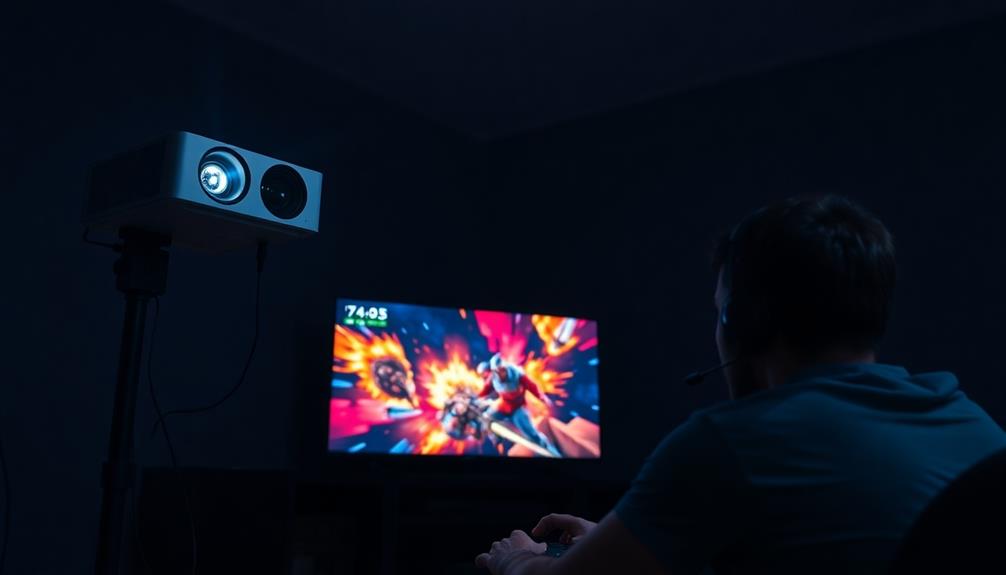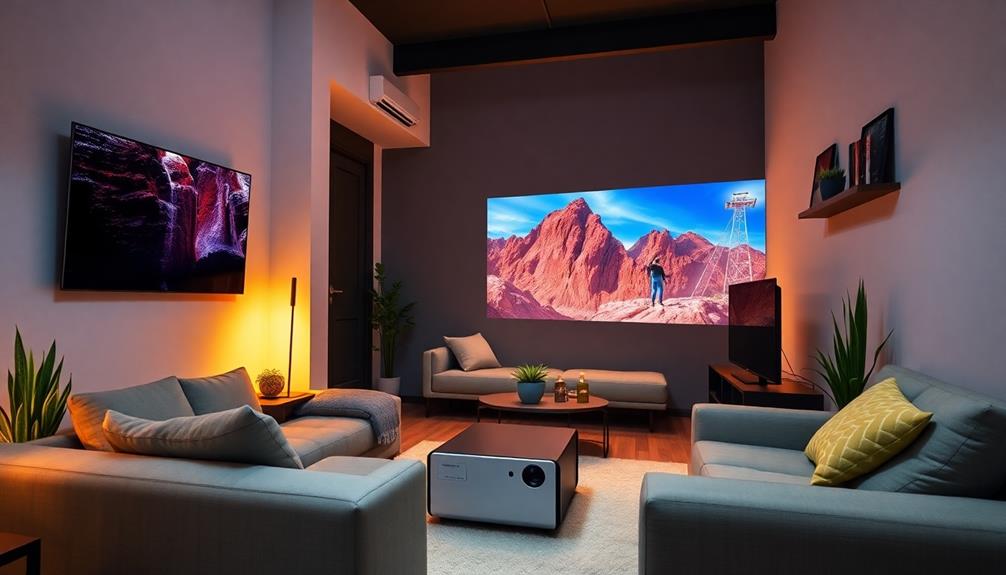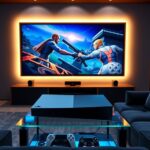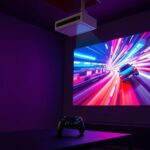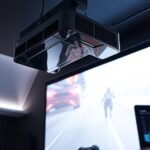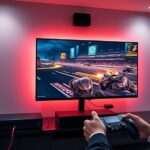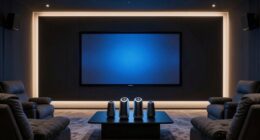To reduce input lag for gaming projectors, start by optimizing your settings. Set your gaming console or PC to output at 1080p and enable the projector's "Fast Mode," which minimizes processing delays. Disable any unnecessary image processing features and activate game mode for maximum responsiveness. Invest in high-quality HDMI cables to prevent signal degradation and guarantee peak performance. Regularly update your projector's firmware to improve compatibility and reduce lag. Finally, consider upgrading to a low input lag model, which can offer response times as low as 4 ms. There's much more to explore on enhancing your gaming experience.
Key Takeaways
- Enable the projector's "Fast Mode" to minimize image processing and reduce input lag significantly.
- Set your gaming console or PC to output at 1080p resolution for optimal performance.
- Disable unnecessary image processing features to lower processing delays and enhance responsiveness.
- Use high-quality HDMI cables that meet HDMI 2.0 standards to maintain signal integrity and reduce lag.
- Regularly update firmware to improve projector performance and compatibility with new gaming devices.
Understanding Input Lag
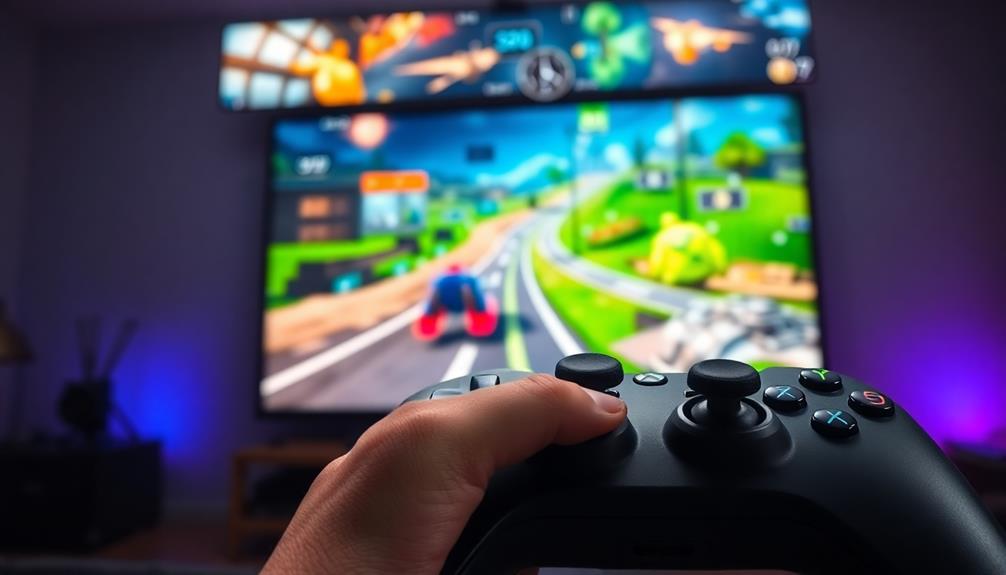
When you're gaming, understanding input lag is essential because it directly affects your experience. Input lag is the time delay between your action and the corresponding on-screen response, typically measured in milliseconds (ms). The lower the input lag, the better the performance of your gaming setup.
For entry-level gaming projectors, input lag can range from 30 to 50 ms, while high-performance models aim for under 15 ms. This difference can greatly impact your gameplay, especially in competitive environments.
When selecting a gaming projector, pay attention to these specifications. Factors like projector processing speed, resolution settings, and the performance of connected devices can influence input lag. Higher resolutions often lead to increased lag, particularly on lower-powered models.
To optimize your gaming experience, consider projectors with a dedicated fast mode. This mode minimizes image processing, markedly reducing input lag. Activating it before your gaming sessions can enhance your performance.
Causes of Input Lag
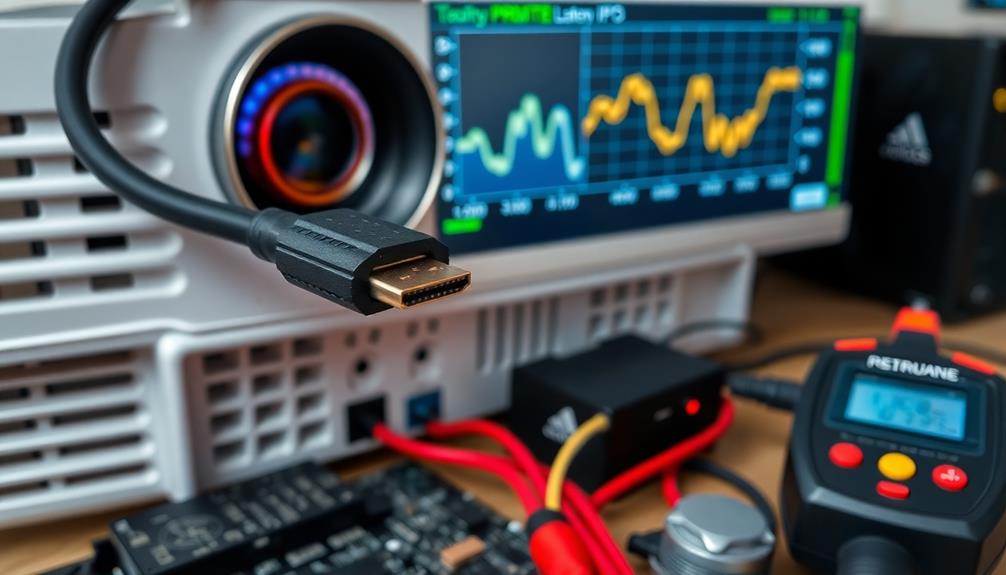
Input lag can really put a damper on your gaming experience, and several factors contribute to it.
Slow processing in projectors often leads to delays, while poor-quality cables can worsen the situation by degrading signal quality.
Additionally, the performance of your gaming console or PC plays a vital role in how quickly your actions register on screen.
Processing Delays in Projectors
Processing delays in projectors can greatly impact your gaming experience, making it essential to understand their causes. One major factor contributing to input lag time is the projector's processor speed. Slower processors take longer to process the video signal, resulting in noticeable delays before the image appears on-screen.
Additionally, when you use higher resolutions on low-power projectors, the input lag can worsen as they struggle to manage the increased data.
Your connected devices, like gaming consoles or computers, also play a role. If they don't output signals efficiently, you'll experience additional processing delays.
Furthermore, features such as image processing, scaling, and frame interpolation can add substantial time to the processing chain, further increasing input lag.
While poor-quality cables can affect signal integrity, this topic will be discussed later. For now, keep in mind that optimizing your projector's settings and using compatible devices can help reduce the impact of these processing delays.
Cable Quality Impact
Using high-quality cables is crucial for minimizing input lag in gaming projectors. The quality of your HDMI cables directly impacts signal integrity. If you use poor-quality cables, you might introduce delays that can contribute to increased input lag.
For ideal performance, especially with 4K content and high refresh rates, you should opt for high-speed HDMI cables. These cables can handle greater bandwidth, reducing the risk of lag compared to standard options.
Another factor to take into account is cable length. Signal degradation can happen over longer distances, so using shorter, high-quality HDMI cables will help maintain ideal performance and minimize input lag.
Additionally, verify that your cables meet HDMI 2.0 standards; otherwise, you could face limitations on refresh rates and resolutions, which may worsen input lag due to potential downscaling or extra processing.
Lastly, don't forget to regularly check and maintain your cable connections. Loose connections or interference can exacerbate input lag in your gaming setup.
Source Device Performance
The performance of your source device plays an essential role in determining input lag when gaming with projectors.
If you're using a gaming console or PC, keep in mind that lower processing power can lead to increased delays in signal transmission. This means that the input lag time advertised can often be misleading if your device can't keep up.
To minimize input lag, consider the following tips:
- Optimize settings: Set your PS5 or other consoles to a higher frame rate, like 60fps, to reduce lag.
- Upgrade hardware: Invest in more powerful source devices if you're frequently playing high-resolution content.
- Use quality cables: High-quality HDMI cables guarantee better signal integrity, which helps reduce lag.
- Stay updated: Regularly update the firmware and software of both your source devices and projector for improved performance.
Measuring Input Lag
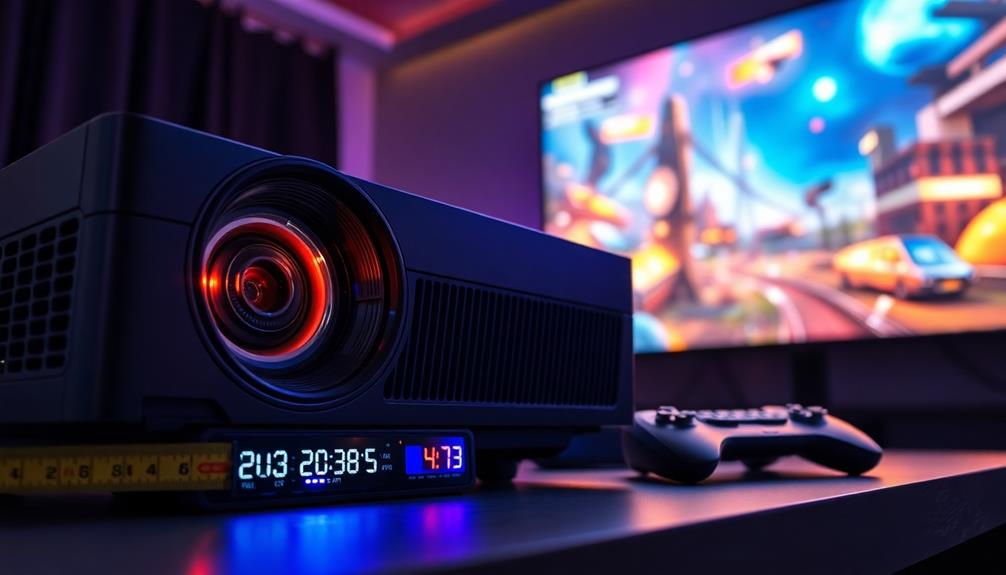
Measuring input lag is essential for optimizing your gaming experience, as lower lag translates to better responsiveness.
You can use various techniques, like high-speed cameras or specialized tools, to get accurate readings.
Factors like resolution and refresh rate also play a significant role, so understanding these elements can help you choose the right projector for your needs.
Importance of Low Lag
Understanding input lag is essential for any gamer looking to enhance their experience with a projector. Input lag refers to the delay between when a signal is received and when the image is projected, typically measured in milliseconds (ms). For gaming, lower input lag translates to better performance and responsiveness.
Here's why low lag matters in gaming projectors:
- Competitive Edge: In fast-paced games, even a slight delay can impact your reaction time.
- Enhanced Enjoyment: A smoother experience leads to more immersive gameplay.
- Precision Control: Low input lag guarantees your actions on-screen match your inputs in real-time.
- Tech Differences: DLP projectors often provide lower latency than LCD projectors due to less processing overhead.
For peak performance, you should look for projectors with input lag below 30 ms, with high-end models achieving as low as 4 ms at 1080p 240Hz.
The difference of just a few milliseconds can make a significant impact, especially in competitive settings.
Prioritizing low lag when choosing your gaming projector will guarantee you get the best possible experience.
Measurement Techniques Available
Accurate measurement of input lag is essential for evaluating a gaming projector's performance. You'll want to know how quickly your projector responds to your commands, and this is typically measured in milliseconds (ms). Lower values indicate better performance, with a 16 ms input lag meaning a 16-millisecond delay from your action to the image on-screen.
To gauge input lag effectively, you'll find several measurement techniques at your disposal. High-speed cameras are particularly useful, as they can capture the delay between your input commands and the resulting on-screen actions. This method provides precise data on your projector's responsiveness.
Additionally, specialized input lag testing tools can systematically measure the time it takes for a signal to be processed and displayed, ensuring you get a clear picture of performance.
Keep in mind that input lag can differ based on projector specifications. Entry-level models often range from 30-50 ms, while high-performance options aim for input lag below 15 ms.
For the most accurate results, it's recommended to use multiple measurement methods, as different techniques may yield varying outcomes in your input lag assessment.
Factors Affecting Input Lag
Several factors play a significant role in determining input lag for gaming projectors, which can greatly impact your gaming experience. Understanding these factors will help you choose a projector that meets your gaming needs.
- Projector Resolution: Higher resolutions can increase processing time, affecting input lag.
- Refresh Rate: A higher refresh rate typically results in smoother motion and reduced input latency, making gameplay more responsive.
- Processing Capabilities: The projector's internal processing power can either enhance or hinder performance, impacting the time it takes for inputs to register on-screen.
- Measurement Techniques: Different testing methods can yield varying results for input lag, so it's important to take into account how the measurements were taken.
Ideally, you want your gaming projector to have an input lag below 30 ms for best responsiveness.
While entry-level models often fall between 30-50 ms, high-performance options can achieve lag under 15 ms.
Remember, input lag measures the delay from your action to the on-screen response, distinct from response time, which measures pixel color changes.
Focus on these factors, and you'll find a projector that enhances your gaming experience.
DLP vs. LCD Projectors
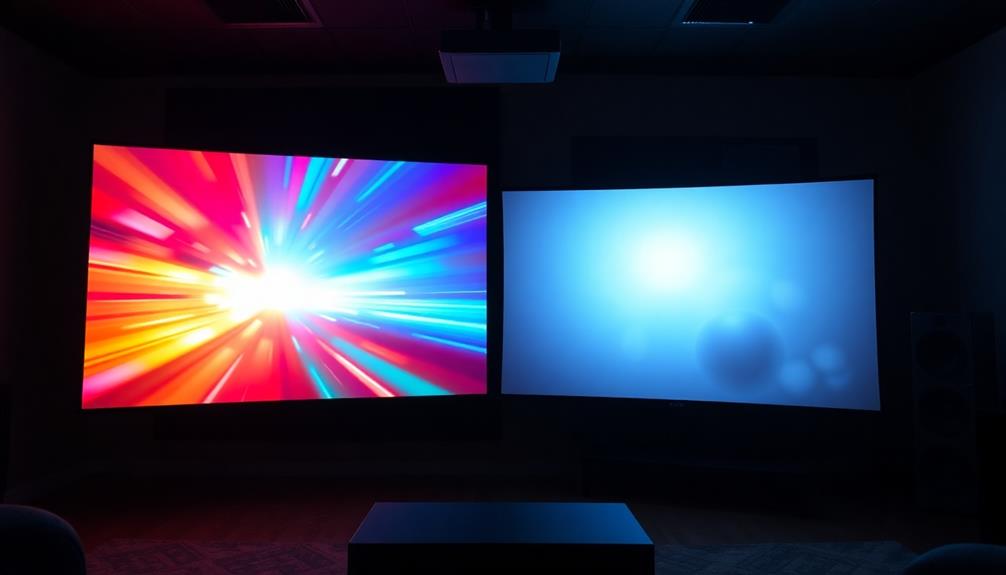
When choosing between DLP and LCD projectors for gaming, it's crucial to take into account input lag, especially if you're a competitive player. DLP projectors typically offer remarkably faster response times, often achieving nearly 0ms input lag. This makes them ideal for fast-paced gaming scenarios, where every millisecond counts.
For instance, a DLP projector can deliver 1080p at 240Hz with just 4ms input lag, while an LCD projector may show an input lag of 18ms at the same settings.
Even when you explore 4K content, DLP projectors maintain a competitive edge with 16ms input lag at 60Hz, while LCD projectors often hit 19ms under similar conditions. This difference is largely due to DLP's reliance on a single chip and faster color wheel speeds, which minimize processing delays.
If you're a gamer focused on competitive play, especially in genres that demand quick reflexes like first-person shooters or fighting games, prioritizing DLP projectors will provide a noticeable advantage in performance.
Ultimately, for a smoother gaming experience, DLP projectors are the way to go.
Optimizing Projector Settings
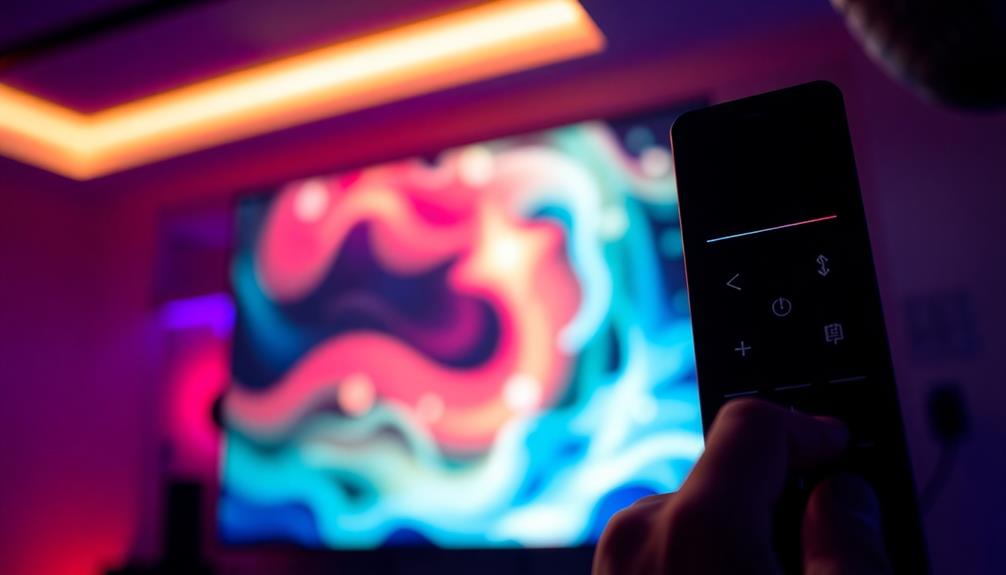
Enhancing your projector settings can make a significant difference in reducing input lag during gaming. By tweaking a few settings, you can elevate your gaming experience and guarantee smoother gameplay.
Start by setting your gaming console or PC to output at 1080p resolution. Higher resolutions can worsen lag issues, so stick to 1080p for peak performance.
Here are some additional tips to help you enhance:
- Enable the projector's "Fast Mode" to boost processing speed for real-time action.
- Turn off image processing features like keystone adjustments and frame interpolation to minimize processing delays.
- Use high-quality HDMI cables to maintain signal integrity and prevent delays.
- Regularly update the firmware of your projector and gaming device for peak performance.
Gaming Mode Benefits
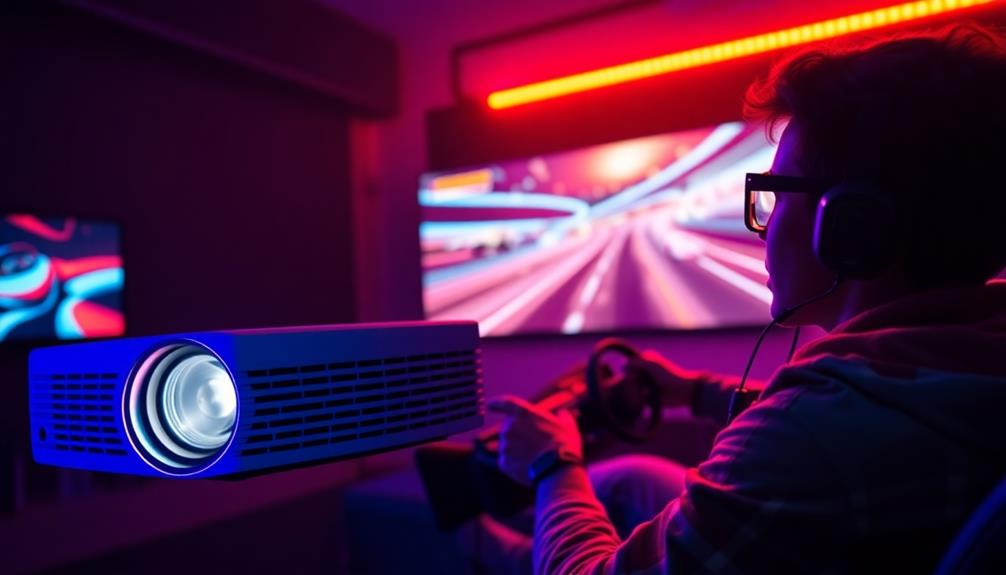
Activating gaming mode on your projector can drastically improve your gaming experience by considerably reducing input lag. In high-performance models, like those from BenQ, input lag can drop to as low as 4ms, compared to the typical 30-50ms you might encounter in standard modes. This significant reduction means your actions translate to on-screen movements almost instantaneously, enhancing your overall responsiveness.
When you enable gaming mode, your projector bypasses unnecessary image processing features, allowing for faster signal processing. This streamlined approach not only boosts your gaming performance but also optimizes video quality, especially in fast-paced genres.
By activating gaming mode before you immerse yourself in your gaming session, you guarantee that your projector operates at its peak, minimizing the risk of lag during those vital moments.
Competitive gamers particularly favor projectors with dedicated gaming modes, as they provide a seamless experience essential for split-second decision-making.
Importance of Quality Cables
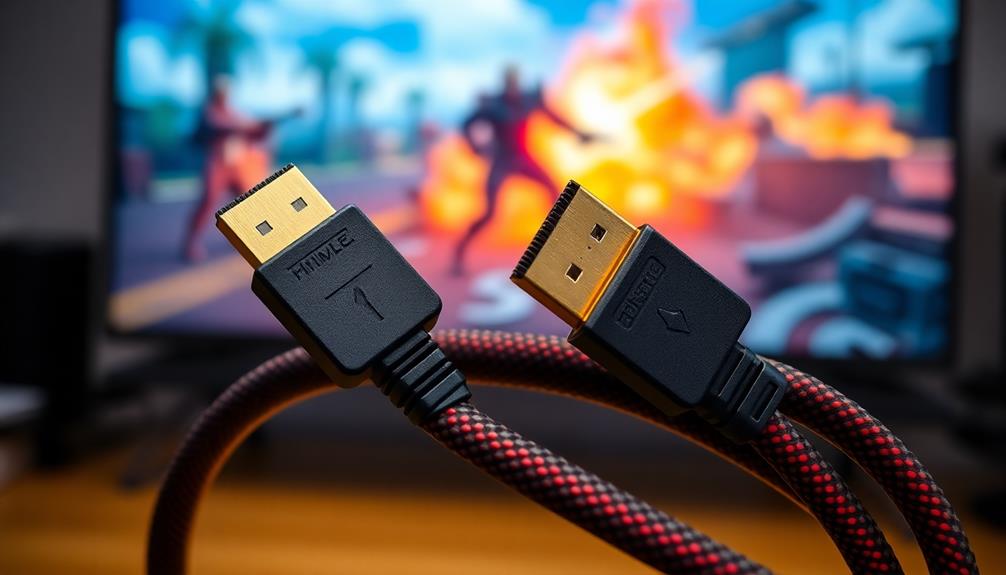
Quality cables play an essential role in guaranteeing an ideal gaming experience with projectors.
Using high-quality HDMI cables is vital for maintaining signal integrity, as inferior cables can introduce additional input lag and degrade video quality.
To enhance your gaming sessions, consider the following:
- Choose certified HDMI cables to guarantee compatibility with high refresh rates and resolutions.
- Invest in high-speed HDMI cables rated for 4K and beyond to minimize input lag, especially when connecting high-data devices.
- Regularly check cable connections for wear and tear to prevent signal loss or interference that can contribute to lag.
- Replace damaged cables promptly to maintain peak projector performance and reduce the chances of input lag during gameplay.
Regular Maintenance Tips

To keep your gaming projector running smoothly, you should establish scheduled cleaning procedures for the lens and filters.
Don't forget to check for firmware updates regularly, as these can greatly enhance performance and reduce input lag.
Scheduled Cleaning Procedures
Keeping your gaming projector in top shape requires regular maintenance to guarantee peak performance and minimal input lag.
Implementing scheduled cleaning procedures is essential. Here are some key tips to follow:
- Clean the air filters every 1 to 3 months to prevent dust buildup, which can cause overheating and increase input lag.
- Schedule a thorough cleaning of the lens every 6 months using a microfiber cloth for best image quality.
- Check and tighten all cable connections, including HDMI and power cables, every 3 months to maintain signal integrity.
- Calibrate settings every 6 to 12 months by turning off unnecessary image processing features to enhance your gaming experience.
Firmware Update Importance
While many gamers focus on hardware upgrades and settings adjustments, regularly updating your projector's firmware is fundamental for minimizing input lag. Firmware updates play an important role in enhancing projector performance by addressing performance issues, optimizing processing capabilities, and fixing known bugs.
By keeping your projector's firmware up to date, you can also improve compatibility with new gaming consoles and devices, which guarantees smoother gameplay and reduced latency.
Manufacturers often release firmware updates specifically targeting input lag reduction, so it's essential to check for these updates periodically. Ignoring firmware updates may lead to persistent lag issues, as older software might struggle to efficiently handle newer content or gaming technologies.
Thankfully, many projectors come equipped with a built-in reminder system for firmware updates, making it easier for you to stay informed about necessary maintenance.
To get the most out of your gaming experience, don't overlook the significance of firmware updates. By prioritizing this important step, you'll not only reduce input lag but also enhance your overall projector performance, making sure you stay competitive in any gaming session.
Upgrading Your Projector
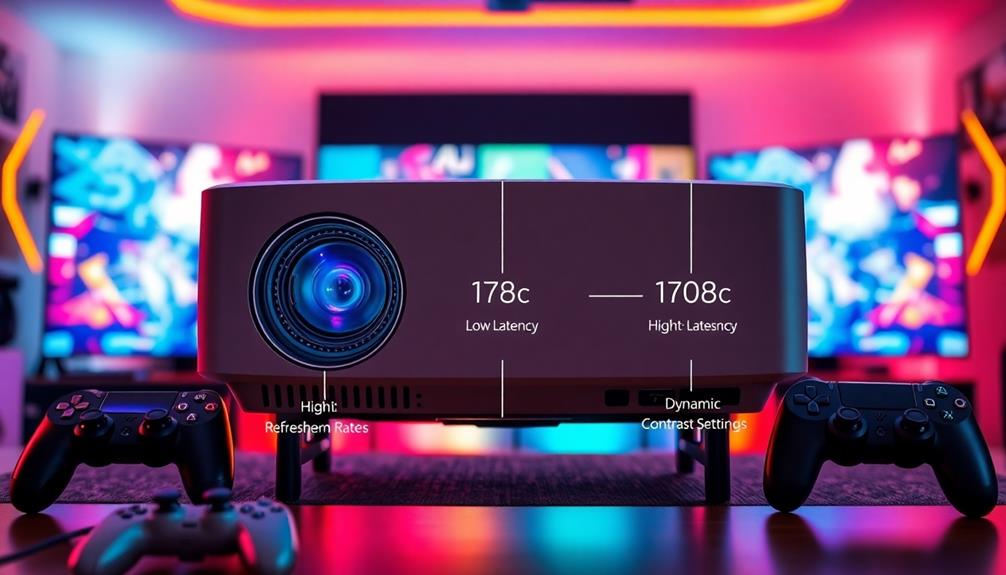
Upgrading your projector can dramatically enhance your gaming experience, especially if you choose a model designed for low input lag. High-performance gaming projectors often feature dedicated game modes that can reduce input lag to as low as 4ms at 1080p with 240Hz refresh rates.
To maximize your gaming setup, consider the following:
- DLP Projectors Better: These typically offer faster response times and lower input lag than LCD projectors, with some achieving nearly 0ms input lag.
- Refresh Rates: Look for projectors with a refresh rate of at least 120Hz for smoother motion and reduced lag.
- 4K Resolution: Invest in a projector that supports 4K at 60Hz while maintaining low input lag for a balance of visual quality and performance.
- Firmware Updates: Regularly check for updates, as manufacturers often release improvements that can further reduce input lag over time.
Community Resources and Support
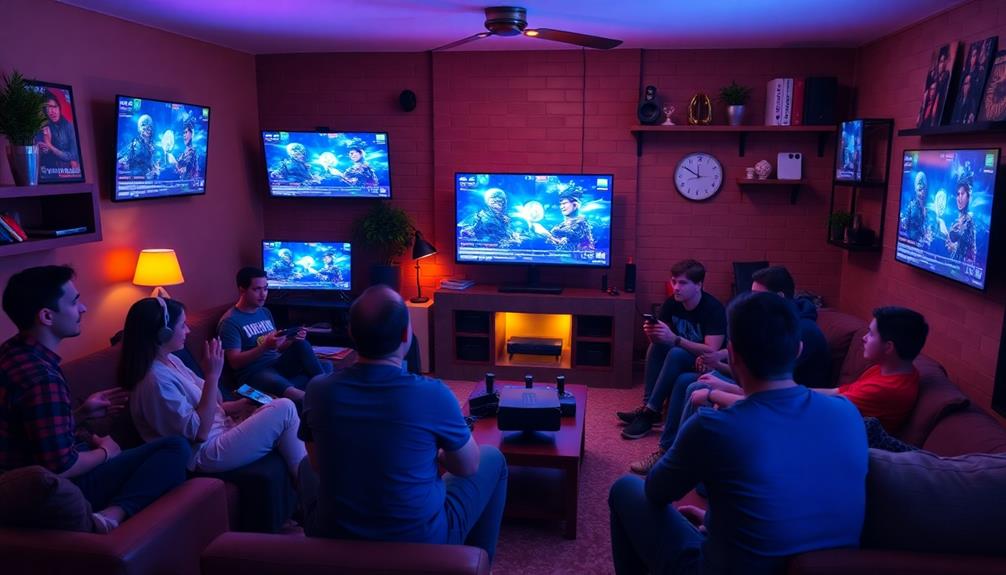
Engaging with community resources can greatly enhance your understanding of how to reduce input lag in gaming projectors. Community forums and online gaming groups are invaluable for sharing personal experiences and troubleshooting tips tailored to specific projector models and setups.
By participating in these discussions, you'll discover recommendations for ideal projector settings, like disabling image processing features to improve performance.
Many technology-focused communities offer resources for input lag testing, including guides on utilizing high-speed cameras or dedicated tools to measure projector responsiveness. These insights can help you pinpoint the exact lag your setup may be experiencing.
Additionally, you can seek advice from experienced users who can assist in identifying high-quality HDMI cables that minimize signal degradation and input lag during your gaming sessions.
Don't overlook local electronics shops or gaming stores, which may host workshops or community events. These gatherings can provide hands-on learning experiences about projector technology and tips for achieving low-lag performance.
Frequently Asked Questions
How Do I Reduce Input Delay in Games?
To reduce input delay in games, start by lowering your resolution to 1080p. Toggle any fast modes, disable unnecessary processing features, use high-quality HDMI cables, and keep your devices updated for peak performance.
How to Measure Projector Input Lag?
Think of measuring projector input lag like timing a sprinter. You'll need high-speed cameras or specialized tools. Focus on milliseconds; lower numbers mean quicker responses. Always check the projector's specs for a clearer picture.
What Is the Response Time of a Gaming Projector?
The response time of a gaming projector refers to how quickly pixels change colors, typically ranging from 16 ms to 30 ms. Lower response times enhance your gaming experience by reducing motion blur and improving visual clarity.
Do Projectors Have a Lot of Latency?
Yes, projectors can have noticeable latency. Entry-level models often lag between 30-50 ms, while high-performance ones aim for under 15 ms. Choosing the right model is essential for minimizing this delay during use.
Conclusion
In gaming, every millisecond counts, so reducing input lag is essential for a smooth experience. By understanding the causes, measuring lag, and optimizing your projector settings, you can greatly enhance your gameplay. Remember, "a stitch in time saves nine"—a little effort in adjusting your setup now can lead to a more enjoyable gaming experience later. Don't forget to maintain your equipment and consider upgrades when necessary. Happy gaming!
